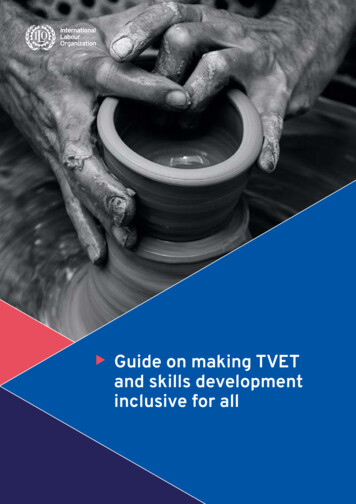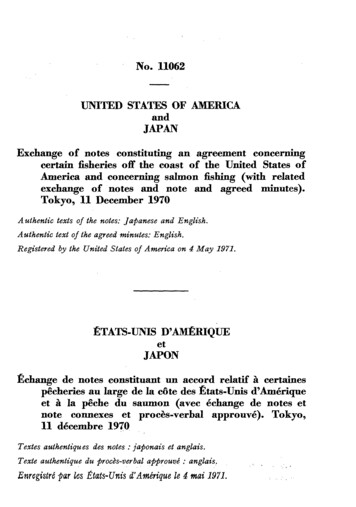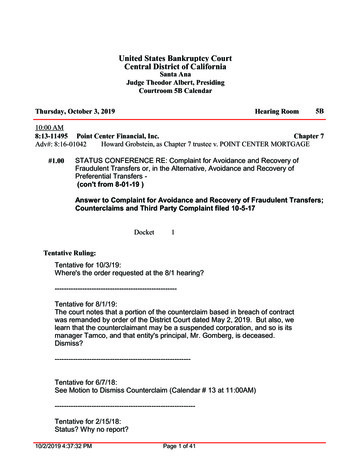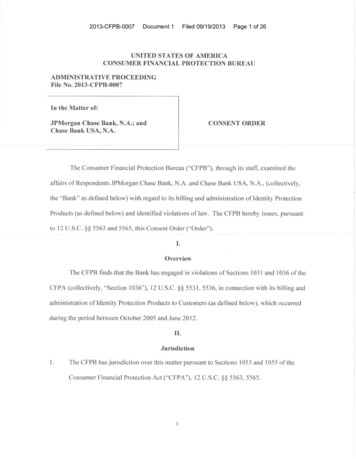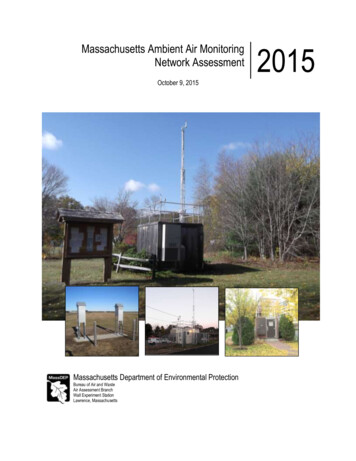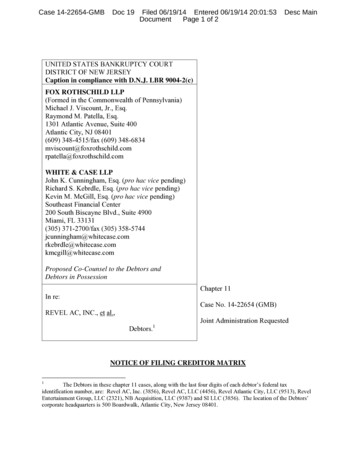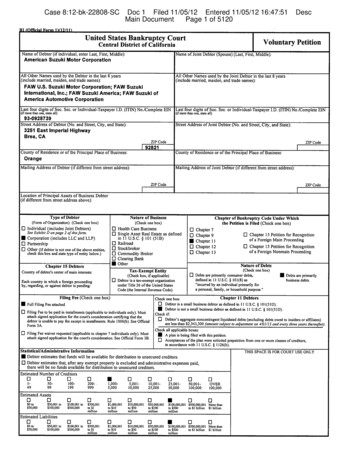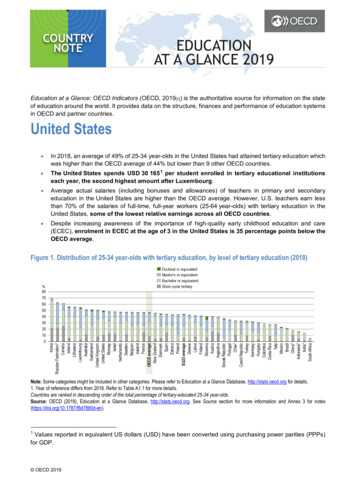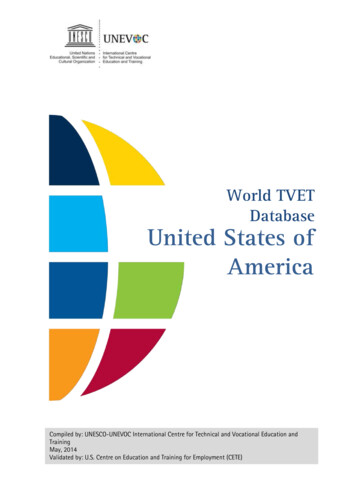
Transcription
World TVETDatabaseUnited States ofAmericaCompiled by: UNESCO-UNEVOC International Centre for Technical and Vocational Education andTrainingMay, 2014Validated by: U.S. Centre on Education and Training for Employment (CETE)
World TVET Database United States of AmericaMay, 2014Compiled byUNESCO-UNEVOC International Centre forTechnical and Vocational Education and TrainingUN CampusPlatz der Vereinten Nationen 153113 BonnGermanyTel: 49 228 815 0100Fax: 49 228 815 0199www.unevoc.unesco.orgunevoc@unesco.orgCountry profiles are compiled from a variety of national and international sources and havebeen informed and validated by UNEVOC Centres in the country or other TVET nationalauthorities.The designations employed and the presentations of material throughout this report do notimply the expression of any opinion whatsoever on the part of UNESCO concerning the legalstatus of any country, territory, city or area or of its authorities, or concerning the delimitationof its frontiers or boundaries.UNEVOC/2014/TVETDB/USA/1 UNESCO 2015All rights reserved2 Compiled by UNESCO-UNEVOC (http://www.unevoc.unesco.org/)
World TVET Database United States of AmericaMay, 2014ContentsAbbreviations .41. TVET mission, strategy and legislation .52. TVET formal, non-formal and informal systems .83. Governance and financing . 104. TVET teachers and trainers . 115. Qualifications and Qualifications Frameworks . 136. Current reforms, major projects and challenges . 147. Links to UNEVOC centres and TVET institutions . 158. References and further reading . 153 Compiled by UNESCO-UNEVOC (http://www.unevoc.unesco.org/)
World TVET Database United States of AmericaMay, VETUSCommon Career Technical CoreCareer PathwaysCareer Technical EducationGeneral Educational DevelopmentNational Association of State Directors of Career Technical Education ConsortiumNational Career Clusters FrameworkNational Qualifications FrameworkOffice of Vocational and Adult EducationTechnical and Vocational Education and TrainingUnited StatesTVETipedia GlossaryBelow are listed TVET terms mentioned in this report. Click on a term to read its definitions onthe UNESCO-UNEVOC TVETipedia glossary.AccountabilityAccreditationAdult nFlexibilityFurther educationHigher educationIn-company trainingInformal LearningJob4 Compiled by UNESCO-UNEVOC (http://www.unevoc.unesco.org/)KnowledgeLabour marketLifelong LearningNational Qualifications FrameworkNon-formal educationOccupationPost-secondary educationQualificationQualityQuality AssuranceSkillsStandardTeacherTeacher In VETTrainerTVETWork experience
World TVET Database United States of AmericaMay, 2014United States of AmericaPopulation:Youth population1:Median population age:Annual population growth(2010-2015)2:321,774,000 (2015)44,010,000 (2015)38.0 (2015)0.75%Data OpenStreetMap Design Mapbox1. TVET mission, strategy and legislationTVET missionThe federal TVET mission is to promote education about work, for work, or education throughwork. Additionally each State has its own TVET mission depending on the regional labour needs.TVET is known in the United States as Career and Technical Education (CTE).TVET strategyThe US vocational improvement strategy promotes links between secondary and postsecondaryvocational programmes to prepare students better for their transition from school to careers.The strategic goals for vocational education, as stated in Strategic Plan FY 2011-2014, are toincrease college access, quality, and completion rates by improving higher education andlifelong learning opportunities for youth and adults: Access: improve the affordability of and access to college and workforce training;Quality: foster institutional quality, accountability, and transparency to ensure thatpostsecondary education credentials represent effective preparation for students toexcel in a global society and a changing economy; andCompletion: increase degree and certificate completion and job placement rates inhigh-need and high-skilled areas.The national policy focuses on developing the academic and technical skills of students, atsecondary and postsecondary levels, by: developing challenging academic and technical standards and supporting students inmeeting such standards, including preparation for high skill, high wage, or high demandoccupations in current or emerging professions;promoting services and activities that integrate rigorous and challenging academic andtechnical training, which link secondary and postsecondary TVET programmes;increasing State and local flexibility in providing services and activities designed todevelop, implement, and improve TVET;1Population aged 14-25All statistics compiled from the United Nation’s Population Division’s World Population Prospects, the2015 Revision (http://esa.un.org/unpd/wpp/DVD/)25 Compiled by UNESCO-UNEVOC (http://www.unevoc.unesco.org/)
World TVET Database United States of AmericaMay, 2014 conducting and disseminating national research and information on best practices thatimprove TVET programmes, services, and activities;providing technical assistance that promotes leadership, initial preparation, andprofessional development at the State and local levels and that improves the quality ofTVET teachers, faculty, administrators, and counsellors;supporting partnerships among secondary schools, postsecondary institutions,baccalaureate degree granting institutions, local workforce investment boards, businessand industry, and intermediaries; andproviding individuals with opportunities throughout their lifetimes to develop, inconjunction with other education and training programmes, the required knowledgeand skills to keep the United States competitive.TVET legislationTVET has been integrated into the United States’ education system through a number oflegislations that have been enacted since 1917. The Smith-Hughes Act of 1917 was the firstauthorisation for the Federal funding of vocational education. Subsequent legislations forvocational education have been enacted as follows: The Rehabilitation Act of 1973 was the Federal legislation that authorised the formulagrant programmes of vocational rehabilitation, supported employment, independentliving, and client assistance. It also authorised a variety of training and servicediscretionary grants administered by the Rehabilitation Services Administration. The Carl D. Perkins Act of 1984 aimed to help states expand and improve theirvocational education programmes, especially in high-poverty areas. Perkins was re-authorised as the Carl D. Perkins Vocational and Applied Technology Act(Perkins II) in 1990. The Act introduced Tech-Prep as a response to increasingrecognition that most technical careers require more than a high school education. The Tech-Prep Education Act was created by the 1990 Perkins Act (Title IIIE). The Actaimed to help students prepare better for future careers. The Carl D. Perkins Career and Technical Education Act of 1998 (Perkins III). The Actproposed to develop more fully the academic, vocational, and technical skills ofsecondary students and postsecondary students. The Workforce Investment Act of 1998 oversaw employment, training, literacy andvocational rehabilitation programs in the United States. The Act established trainingcentres, individual training accounts and State and local Workforce Investment boards. The Carl D. Perkins Career and Technical Education Act of 2006 (Perkins IV) required allrecipients of its funds to offer a programme of study that combines at least two yearsof secondary education with postsecondary education or training that may extend tothe baccalaureate.6 Compiled by UNESCO-UNEVOC (http://www.unevoc.unesco.org/)
World TVET Database United States of AmericaMay, 2014 The Elementary and Secondary Education Act of 2002 funds K-12 education in thestates and emphasises equal access to education, high standards and accountability.Sources:Careertech (2014). CTE Vision. Accessed: 08 July 2014.Stone III, J.R., and M.V. Lewis (2010). Governance of Vocational Education and Training in theUnited States, Volume 5. Oxford: Research in Comparative and International Education.U.S. Department of Education (2011). Strategic Plan for Fiscal Years 2011-2014. WashingtonD.C.: U.S. Department of Education. Accessed: 21 August 2013.7 Compiled by UNESCO-UNEVOC (http://www.unevoc.unesco.org/)
World TVET Database United States of AmericaMay, 20142. TVET formal, non-formal and informal systemsScheme compiled by UNESCO-UNEVOC from U.S. Department of Education (2011). Digest ofEducation Statistics. Washington D.C.: National Center for Education Statistics.Formal TVET systemTVET programmes in the United States are aligned according to National Career Clusters(agriculture, architecture government, finance etc.) and are taught in non-parallel subsystemswith few structural connections between them. US TVET takes place in: a public education system largely limited to high school;8 Compiled by UNESCO-UNEVOC (http://www.unevoc.unesco.org/)
World TVET Database United States of AmericaMay, 2014 community or technical colleges serving a wide range of public needs;various government programmes;a miniscule apprenticeship system; anda large business-based training system disconnected from all of the others.In total, about 12.5 million high school and college students are enrolled in CTE in the UnitedStates.Students ordinarily after spending 6 to 8 years in elementary school continue a 4- to 6-yearprogramme in academic, vocational or technical secondary school. Students normally completethe high school programme through grade 12 by age 18. Education at the secondary level isprovided in a range of institutional settings—including junior high schools, high schools, seniorhigh schools, and combined elementary/secondary schools—that vary in structure from localityto locality. The average high school student takes more TVET credits than any other subject areaexcept English. Relatively few students, however, take a sufficient number of credits to lead toan industry-recognised credential.High school graduates who decide to continue their education may enter a technical orvocational institution, a two-year community or junior college, or a 4-year college or university.A 2-year college normally offers the first 2 years of a standard 4-year college curriculum and aselection of terminal TVET programmes. Academic courses completed at a 2-year college areusually transferable for credit at a 4-year college or university. Post-secondary TVET alsoincludes offerings from proprietary post-secondary schools, adult learning centres, professionalassociations or labour unions, and government agencies.Tech-PrepTech-Prep combines academic and vocational courses and through articulation agreements itlinks high school studies to advanced technical education in community and technical colleges,apprenticeship programmes or other post-secondary institutions. A key feature of Tech-Prepprogrammes is to apply academic instruction through teaching academic subjects in a practical,hands-on way, drawing on careers of interest as a context for examples, assignments, andprojects.The agreement outlines the criteria students must meet in order to receive post-secondarycredit for the courses studied at the secondary level. The credits the students earn in highschool are redeemed at the post-secondary level as they continue taking courses in the sameoccupational area.Career Pathways (CPs)CPs specify the knowledge and skills that students must acquire at the secondary andpostsecondary levels in order to be better prepared for occupations within various careerclusters. CPs are adopted by the Office of Vocational and Adult Education (OVAE) and defined asa coherent, articulated sequence of rigorous academic and career courses, commencing in theninth grade. A Career Pathway is developed, implemented, and maintained in partnership withsecondary and post-secondary education, business, and employers. CPs are available to allstudents, including adult learners, and are designed to lead to rewarding careers.9 Compiled by UNESCO-UNEVOC (http://www.unevoc.unesco.org/)
World TVET Database United States of AmericaMay, 2014The Job CorpsAnother federal programme, the Job Corps, targets at-risk youth and combines intensive skilltraining and academics designed to help youth obtain a General Educational Development (GED)certificate by passing a series of standardised tests normed to reflect a level of skills andknowledge equivalent to that signified by a regular high school diploma.The Job Accommodations NetworkAnother federally funded programme that targets youth with disabilities is the JobAccommodations Network. It is not merely a programme but a technical assistance serviceprovided to employers to attract, hire, and retain young workers with disabilities.Non-formal and informal TVET systemsApprenticeship Programmes are often ta
World TVET Database United States of America May, 2014 Compiled by UNESCO-UNEVOC International Centre for Technical and Vocational Education and Training UN Campus Platz der Vereinten Nationen 1 53113 Bonn Germany Tel: 49 228 815 0100 Fax: 49 228 815 0199 www.unevoc.unesco.org unevoc@unesco.org
